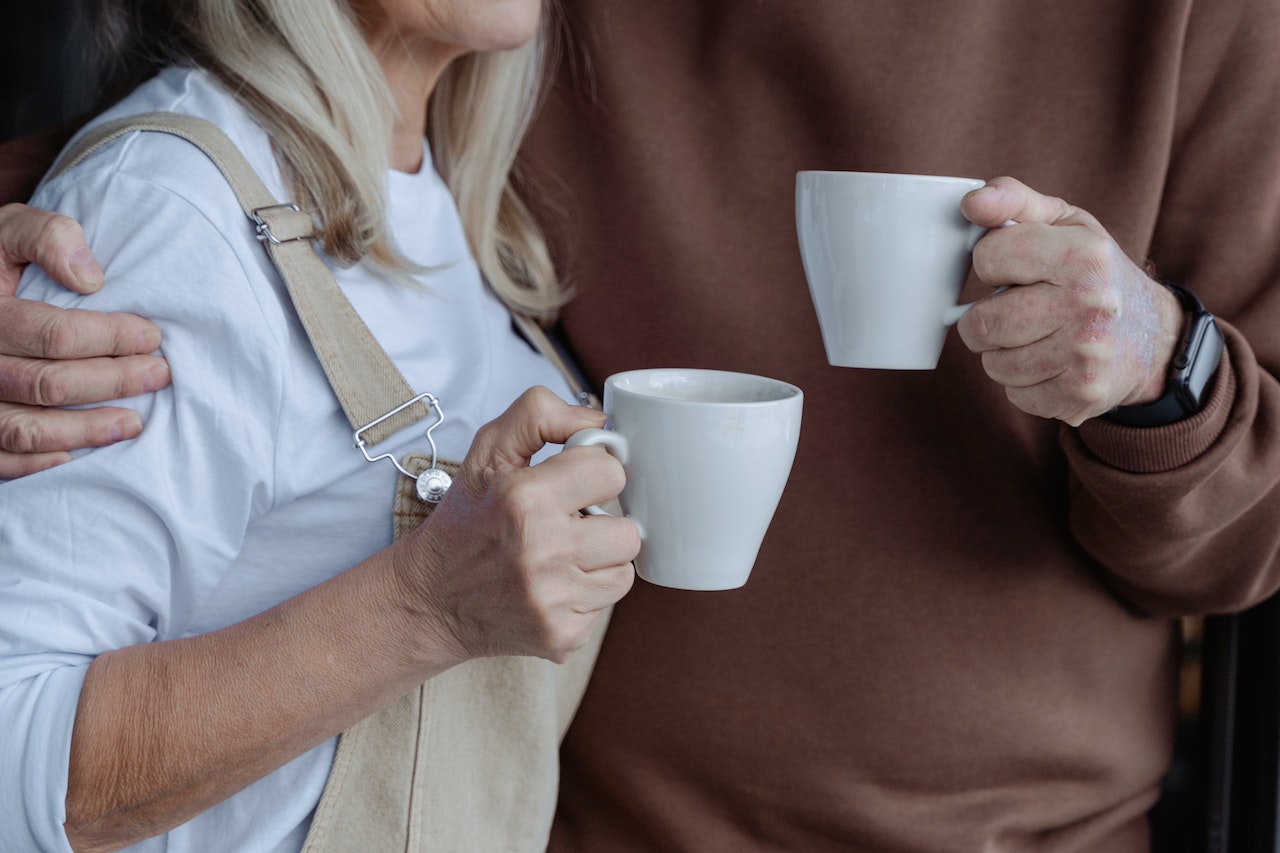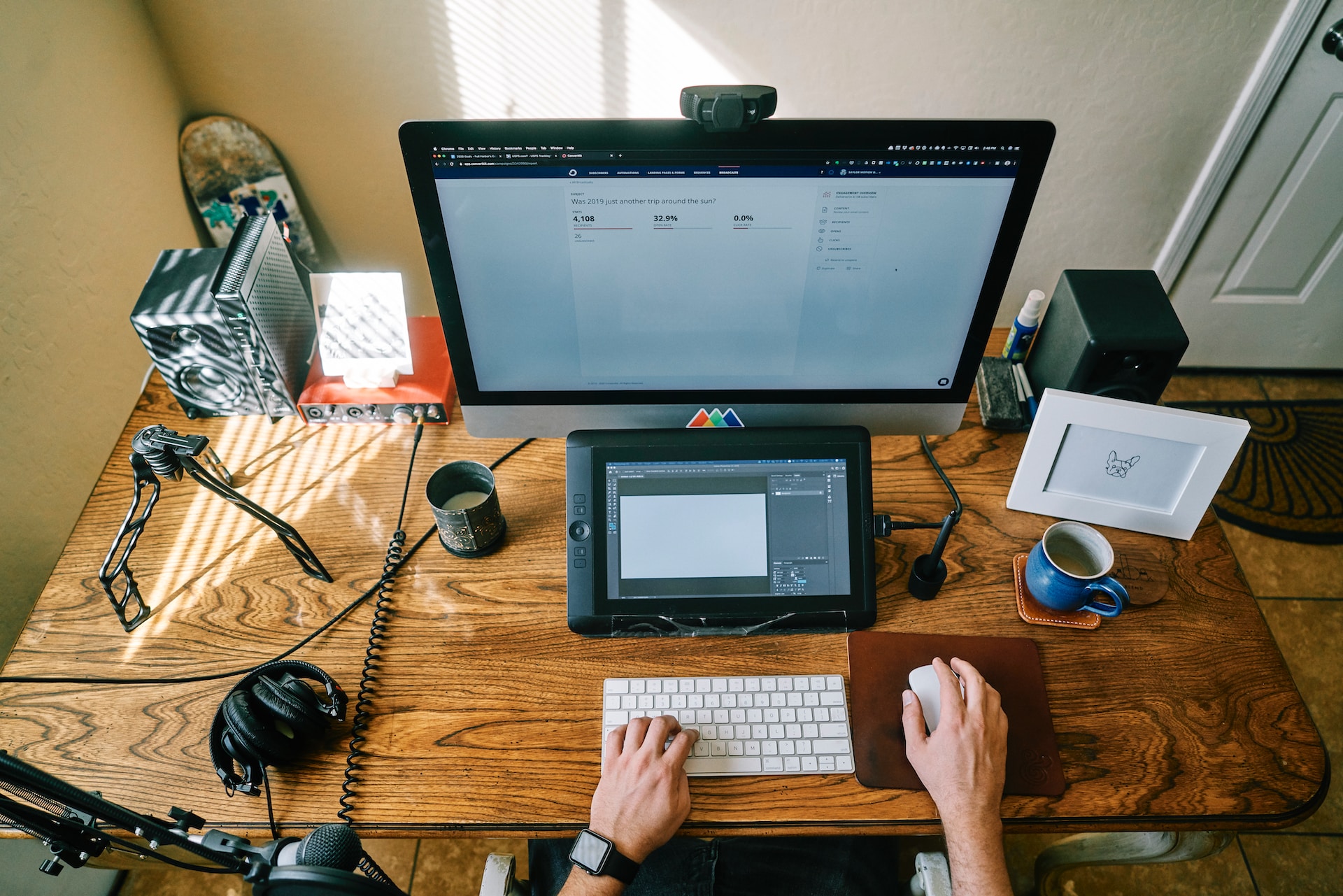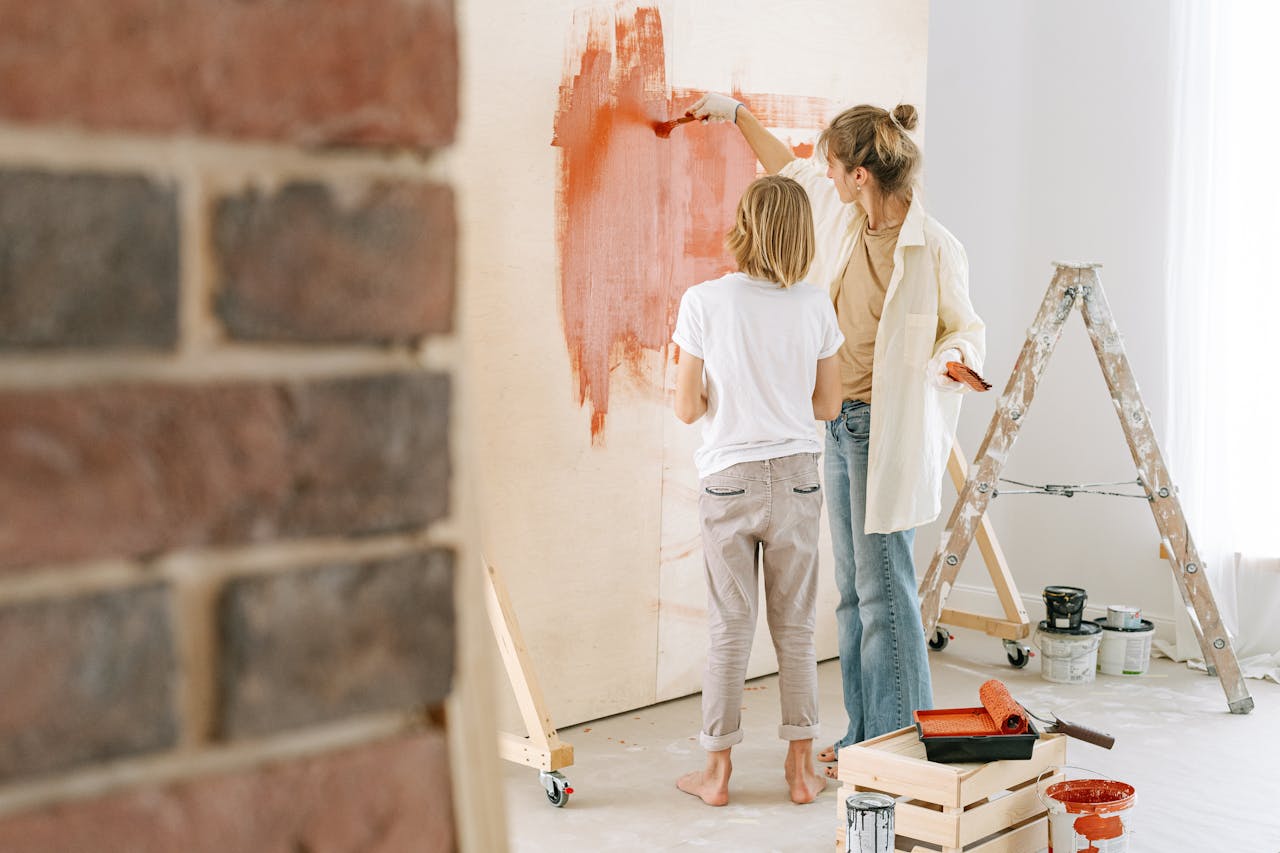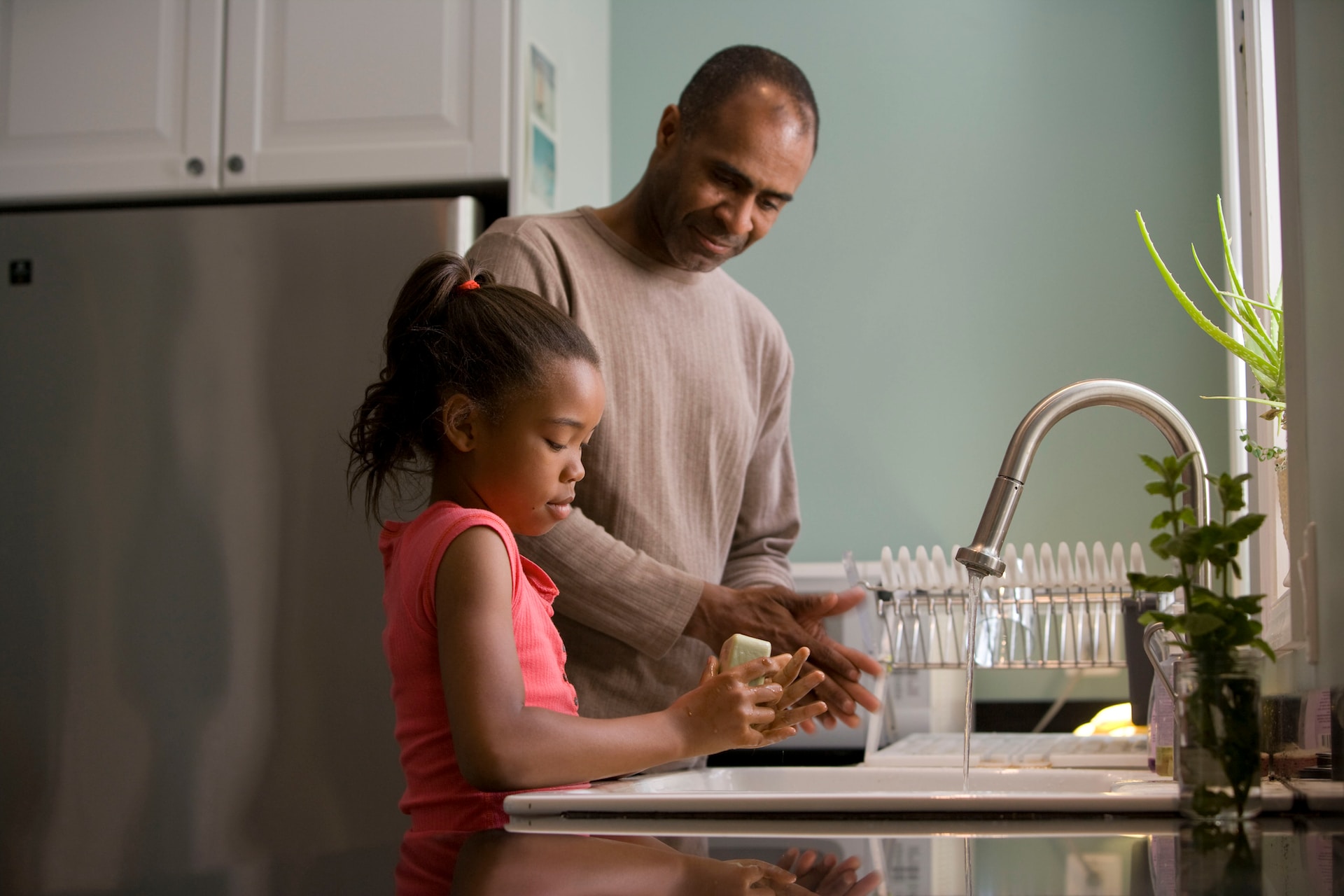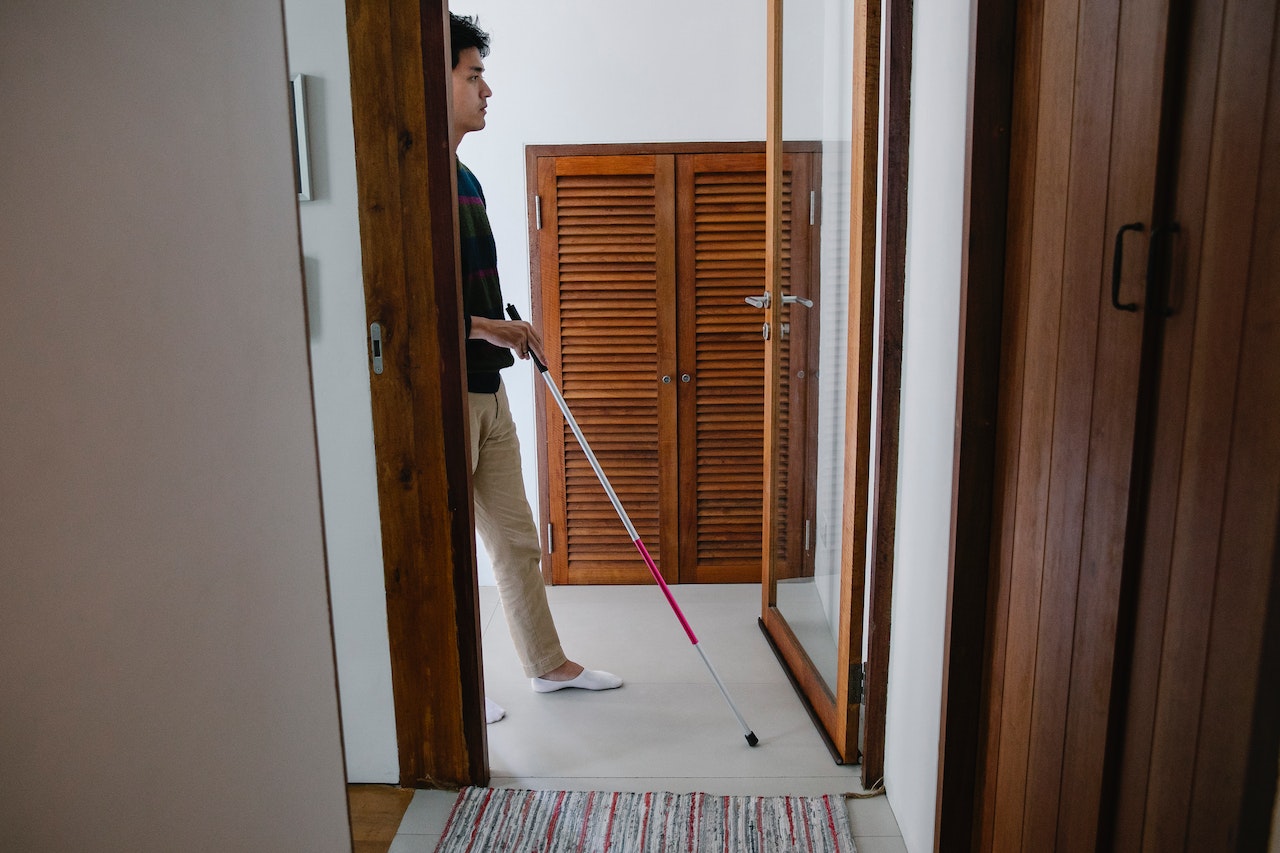As individuals grow older, they often face unique challenges that may impact their overall well-being, changes in vision, hearing, and mobility, making seniors susceptible to accidents. Prioritizing home safety can help older adults maintain independence while minimizing potential risks. Implementing a range of precautions and modifications can significantly reduce the likelihood of accidents, ensuring a safer living environment for seniors.
Table of contents
- General home safety measures
- Kitchen safety
- Bathroom safety
- Smart gadgets for home safety
- Additional considerations
- Final thoughts
General home safety measures
Maintaining a safe home environment is crucial for individuals of all ages, but it holds particular significance for seniors. By addressing potential hazards and implementing preventive measures, such as accessibility, lighting, and installing handrails, older adults can significantly reduce the risk of accidents.
Functional fittings to be installed in the home to make everyday tasks easier for seniors
Aging has its challenges, causing issues with mobility and agility that make simple everyday tasks difficult. Here are a few useful fittings that help ease daily routine tasks for seniors.
- Ventilation: Seniors with respiratory conditions may feel lightheaded with inadequate ventilation. Air vents can improve airflow, especially in steam-prone areas like the washroom and kitchen.
- Rails and ramps: Rails should be installed for stairways next to the bed, bathroom, and bathtub. If moving around is exceedingly difficult, swap out steps for ramps wherever possible.
- Light switches: Replace the standard light switches with larger “rocker” type switches that are easier to see and use.
- Door Handles: To help seniors with stiff hands, replacing door knobs with levers is helpful. Opting for archways and sliding doors also makes a difference.
- Windows: Opt for windows that can be opened or closed with ease.
- Doorbells, Intercoms, and Phones: Older adults often have difficulty hearing doorbells. Hence, installing intercoms in every room is advisable, especially if they live alone.
- Visual cues: Ways to transform audible cues into visual ones can help if the person has trouble hearing. Choose electronic devices that visually indicate task completion, such as ovens, dishwashers, and washing machines.
Koyel Shee from MYA CARE
Home safety tips for aging parents
Most older adults want to stay at home for as long as they age. However, adult children might notice that an aging parent isn’t as safe at home due to challenges that might come with decreased mobility, chronic pain, cognitive decline, or lower endurance. You can make some adjustments to their home that can keep them safer and more independent for longer.
First, focus on one of the most dangerous rooms in the home: the bathroom. Consider installing grab bars near the toilet and in the shower. Use slip-proof flooring in the shower and install a shower chair and handheld showerhead. Finally, secure any rugs in the bathroom.
Next, focus on lighting. Poor lighting can significantly increase the risk of falling at home. Use nightlights to illuminate the path from the bedroom to the bathroom for middle-of-the-night bathroom trips and add lighting to dark areas like stairwells and hallways.
It’s also a good idea to remove clutter, power cords, and bulky furniture from the most used pathways of the home. If your loved one uses a walker or cane, ensure they can easily get the device through the house, from the living room to the kitchen, or down the hall to the bathroom. While removing clutter and potential fall hazards, take time to secure rugs throughout the house as well.
Finally, be sure your loved one has a way to call for help in case an emergency or fall happens. Today’s medical alert devices have come a long way from the “I’ve fallen, and I can’t get up” days. You can find devices and systems that will suit your loved one’s style, preferences, and budget.
Haley Burress from Medical Alert Advice
Tips for fall prevention
There are many valuable tips to help mitigate the risks of falling for older adults. It is vital to take action before you experience the first fall because the statistics show that one fall will likely precipitate another one within a year.
One of the most dangerous places in the house is the bathroom, with slippery surfaces, hard flooring, water, and soap products. This is a perfect place to start fall prevention by installing grab bars. These are important in the shower, tub area, and near the toilet, and many companies make stylish and practical grabs, including towel racks, soap dishes, and toilet paper holders. They are important for guests and family members, as well!
Along with the grab bars, look around the house for tripping hazards like extension cords, clutter in pathways, and dark corners or hallways. Adding extra lighting in every room, even dusk-to-dawn lights and motion sensors, can add essential safety to the home.
More fall prevention tips also require proactively protecting our safety and independence. These include regular exercise to promote balance, flexibility, and strength. Walking, stretching, and even chair yoga will increase physical well-being.
It is important to make appointments with our healthcare providers for annual vision and hearing check-ups. There can be very subtle changes over time that contribute to the minor distraction that could cause a fall. An annual medication review is also vital, especially if a person is taking five or more medications or if a new medication is prescribed. There may be interactions or side effects that will change as we age, including the effects of vitamins and supplements.
The crucial tip for fall prevention is to take action and simple steps to safeguard well-being and independence.
Fritzi Gros-Daillon, Director of Education, Age Safe America
What is universal design, and why is it suitable for aging-in-place home modifications?
Universal Design (UD) is a set of principles for creating adaptable and inclusive living spaces for people of all ages and abilities. In homes, UD improves convenience, usability, and safety for all household members, regardless of their physical or cognitive abilities. It maximizes accessibility, enabling independent navigation and use of home features.
Common UD modifications include grab bars, widened doorways, lever-style handles, non-slip flooring, adjusted countertop heights, ample lighting, zero-step entrances, contrasting colors, and open floor plans.
Universal Design supports aging in place by creating a living environment that adapts to changing needs over time, thus minimizing future costly modifications or relocation. It enhances freedom, mobility, and safety, reducing the risk of accidents and falls, especially for older adults or those with mobility challenges. And it makes daily tasks and activities more effortless.
Many worry that designing for aging in place requires compromising aesthetics for functionality. Yet UD eliminates the institutional look often associated with accessibility modifications. It seamlessly combines functionality with aesthetics, increasing market value and appealing to a broader range of potential buyers who value accessibility and inclusive design.
Implementing UD is a proactive way to plan for an unknown future. It allows individuals to live comfortably and independently in their homes for as long as possible.
Lori Bellport, Founder of Live in Place Designs
Four areas that require special attention in safe-proofing your home as you age
There are four obvious areas of the home that need special attention when we’re concerned for seniors’ safety.
- Stairways. Ideally, you don’t deal with stairs after, say, age 75 or if you have bad knees or hips or are prone to falling. If you don’t like stairs, remove them from your life. Adequate handrails are the preeminent safety remedy. Carpeting vs. hardwood each has its dangers.
- Kitchens. Make sure that there is a fire extinguisher handy – or even two. Use the most up-to-date technology. For example, Smart appliances like the iGuardStove shut themselves off automatically. Kitchen work around the stove and oven is dangerous for people with waning strength.
- Bathrooms. Grab bars, walk-in showers, shower chairs, textured no-slip flooring, and raised toilets top the features that make this slipperiest of rooms safer. Also: avoid rugs on the floor. Use a removable shower head.
- Hallways are also something to be mindful of. Every part of seniors’ homes should be well-lit for optimal safety. Consider adding bright lamps where needed but keep things from clogging up in any way.
If seniors are lucky enough, they reach a point where a seniors’ building – built with their needs in mind – truly becomes the best option. Optimally accessible explicitly for people of their vintage, it also comes with a built-in peer group they’ll connect with.
Jim Huinink from Comfort Life
Home safety checklist for seniors living alone
Living alone as a senior can come with unique safety concerns. To help ensure a safe living environment, here’s a home safety checklist for seniors living alone:
- Lighting: Ensure proper lighting in all areas, including hallways and entrances. Add nightlights for visibility at night.
- General Safety: Remove tripping hazards, secure rugs, and clear cluttered walkways.
- Fire Safety: Install smoke detectors on each floor, have fire extinguishers, and develop a fire escape plan.
- Emergency Preparedness: Keep emergency numbers accessible, have a charged cellphone, and consider a personal emergency response system.
- Home Security: Install secure locks, use a peephole or doorbell camera, and consider a security system.
- Medications: Organize medications, use pill organizers, and regularly check for expired medications.
- Bathroom Safety: Install grab bars near the toilet and shower, use non-slip mats, and ensure proper ventilation.
- Kitchen Safety: Store frequently used items within reach, use appliances with safety features, and have a fire extinguisher handy.
- Fall Prevention: Install handrails on stairs, use non-slip mats, and consider a medical alert system.
- Regular Maintenance: Keep up with home maintenance, including repairs and inspections of electrical and plumbing systems.
- Social Connection: Stay connected with family, friends, or neighbors and have regular check-ins for support and assistance.
Remember, this checklist serves as a general guide. It’s important to assess individual needs and consult professionals for personalized safety recommendations.
Linda Bohmbach from Home Healthsmith
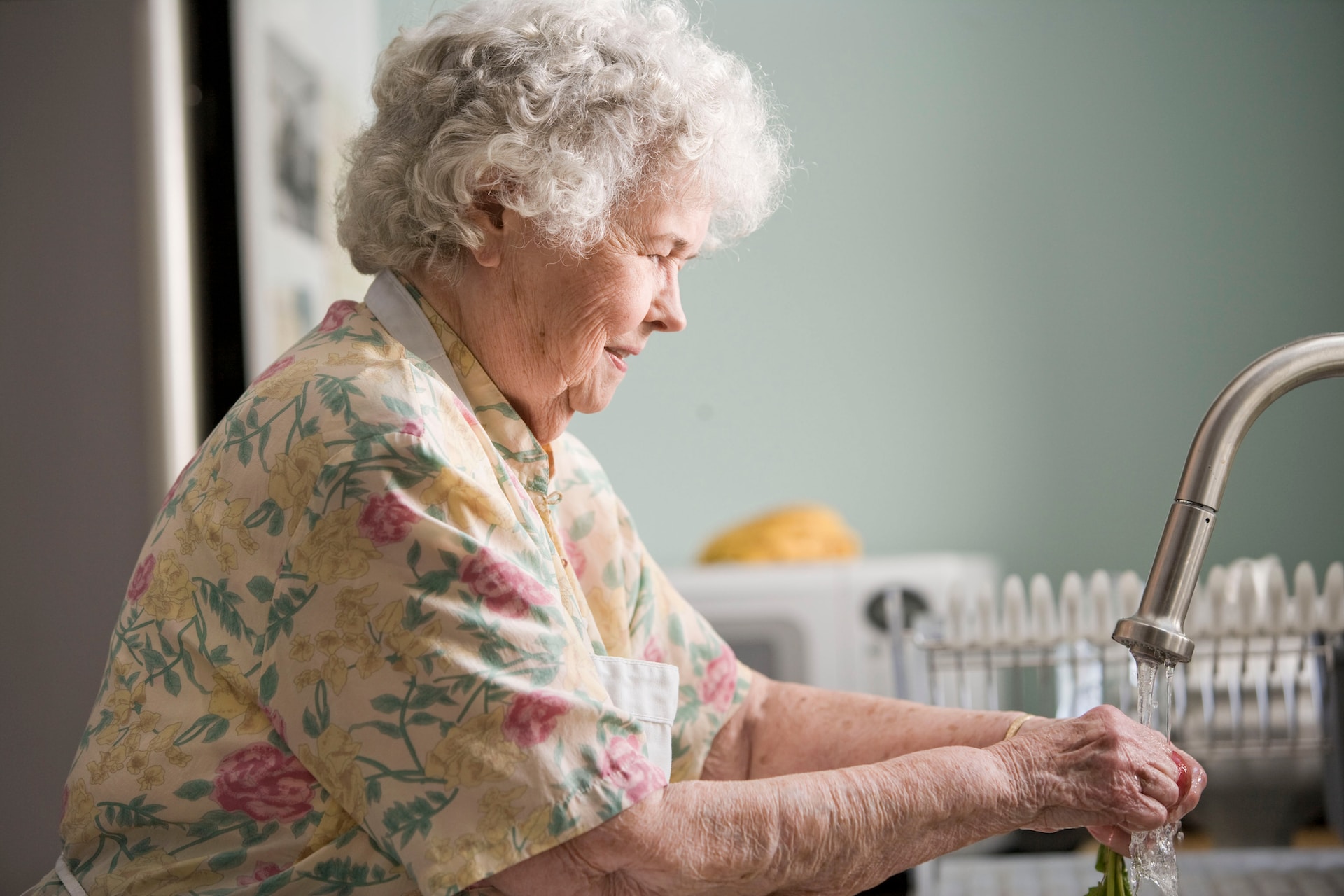
Kitchen safety
Kitchen safety is paramount for seniors to prevent accidents and injuries. They should ensure proper use and maintenance of kitchen appliances, following the manufacturer’s instructions. Take extra precautions when using the stove to prevent burns and scalds by using oven mitts, avoiding loose clothing near flames, and being mindful of hot surfaces. Safe handling and storage of knives and utensils are important to prevent cuts and accidents.
Kitchen safety modifications
Some modifications can be made to help seniors prevent accidents, maintain their independence, and continue cooking confidently. According to AARP, approximately 77 percent of adults over 65 want to remain in their current homes as they age. The kitchen is an important room in the house that may require changes to promote safety and independence in the years to come. Though some modifications are costly, others are much simpler and less expensive.
8 simple kitchen safety modifications to help age in place comfortably:
- Move items used most often to cabinets within reach.
- Remove infrequently used items to reduce clutter and make it easier to find things.
- Use lightweight dishes, pots, and pans to reduce the risk of dropping them. Strength tends to decrease for many of us as we age.
- Cook with pots with two handles to make them easier to hold and prevent spills.
- Install easy-to-hold handles on cabinets and doors. Pull handles on drawers are easier for those with arthritis or shaking hands.
- Install bright lighting in the kitchen to reduce injuries due to falls or other accidents.
- If an appliance such as a microwave over the stove or oven is hard to reach, relocate it. For example, place the microwave on the counter or consider installing a microwave drawer in the lower cabinetry.
- Install a faucet with a long neck to bring water closer so leaning forward when doing the dishes is not necessary. Not having to lean helps reduce fatigue.
Leslie Farin from 50PlusToday Online Lifestyle Magazine
Top 5 kitchen safety tips that seniors need to consider
1. Install automatic stove shut-off devices: These helpful gadgets automatically turn off the stove if it is too long or in the event of a fire. They are available in both electric and gas stove options.
2. Use lightweight cookware: Lightweight pots and pans are more manageable for older adults, especially if they have poor grip strength or pain from arthritis. This tip reduces the risk of dropped foods reducing the chance of spilling hot food or liquids, which could cause significant injuries.
3. Use electric kettles with automatic shut-off: These devices are handy for heating water quickly and safely for making tea or heating water for mixing in condensed soups. This reduces the chance of a burn when heating water and ensures the kettle isn’t left on for too long, preventing potential accidents.
4. Use a timer: When cooking, it’s easy for most people to forget about the food on the stove. A simple timer like an old-fashioned egg timer will remind seniors when to check or remove the food, preventing burnt, wasted food or possible fires.
5. Avoid Loose Clothing: Loose clothing with baggy sleeves can catch fire more easily than short or snug sleeve ends. Remember to robes and pajamas if breakfast is cooked before you wear the day’s clothing.
Scott Grant from Graying with Grace
Bedroom safety
Living room and bedroom changes
Adapting a living space for seniors should focus on minimizing risks while promoting independence. I recommend replacing traditional flooring with non-slip options to prevent falls. Lever door handles and rocker light switches can be easily operated, accommodating reduced hand dexterity.
In the bedroom, consider adjustable beds and ample lighting with accessible switches to support visibility and mobility. Living rooms can be enhanced with automated recliners and furniture arranged to create clear walkways, reducing the chances of trips and falls.
For a truly senior-friendly home, incorporate smart home devices that can monitor health, control lighting, and manage thermostats remotely, providing peace of mind to residents and their families.
These changes go beyond mere functionality; they are about crafting spaces that respect the dignity and lifestyle of our respected elders.
Brad Smith from Omni Home Ideas
Bathroom safety
Slip and falls in the bathroom are commonplace for everyone. Still, seniors should take proactive measures to ensure a safe bathroom environment for maintaining independence and minimizing the risk of falls. By addressing key aspects of bathroom safety, older adults can create a secure and accessible space by installing grab bars, adding non-slip mats, and optimizing accessibility.
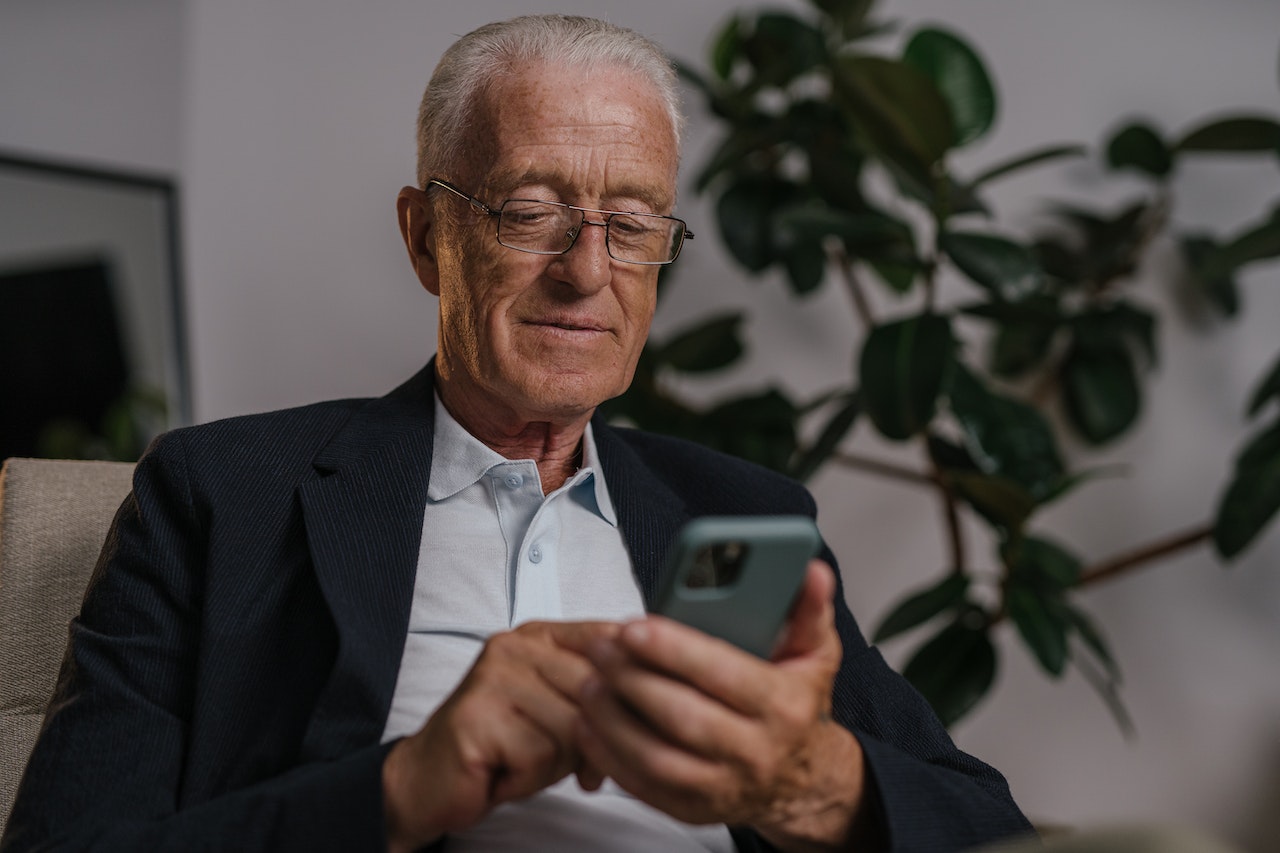
Bathroom safety tips for seniors to consider
The bathroom is an essential part of any house, but it is also the room where most falls for older adults occur, ranging from minor bruises to serious injuries. What are the situations putting older adults at risk? Having mobility problems makes it harder to get in and out of the tub, shower, or on or off the toilet. Also, environmental factors like clutter, bathroom rugs, slick tile floors, or poor lighting increase the odds of falling.
But this doesn’t need to be the case with attention to a few tips for making the bathroom safer.
- Install grab bars in the shower, beside the tub, and at the toilet. This should probably be done professionally, but agencies providing services to older adults may be able to install it at no or reduced cost.
- Place a non-slip mat on the shower or bathtub floor and a non-slip rug on the adjacent floor to counter slippery surfaces.
- Use a shower chair to prevent slips and falls, and consider a sturdy bench to help with transfers in and out of the bath.
- Get a nightlight or motion-activated light to provide adequate lighting for nighttime bathroom visits.
- Avoid potential burns by keeping hot water temperatures at a maximum of 120F.
Dr. Marcia Ory from Vital Record
What are the most effective anti-slip floor solutions that can be easily installed in bathrooms and other high-risk areas to help prevent falls for seniors aging in place?
There are a lot of options out there to help folks increase traction on their slippery floors, but unfortunately, a lot of those options are temporary fixes or do not work well at all. Floor “treatment” products are only going to etch tiny pores into a flooring surface, but once those tiny pores are filled with dirt, you’re back to square one. Then you’ve got to use the product again and again and again. SparkleTuff Anti-Slip Floor Coating, on the other hand, is a virtually permanent solution. It’s been tested for slip resistance with reliable test methods (unlike the etching products previously mentioned) and has been designed to last many, many years. With SparkleTuff Anti-Slip Floor and Tub Coating, you’ll do it once and be done indoors or outdoors. Looks great – no slips! For small areas like stairs and tubs, anti-slip grip tapes can also be extremely helpful.
Safety Direct America
Smart gadgets for home safety
Technology has revolutionized home safety, offering innovative solutions to protect seniors and promote well-being. Smart gadgets enhance security and prevent accidents. Medical alert systems with fall detection and emergency response capabilities provide prompt assistance during emergencies. Smart doorbell cameras offer enhanced security and real-time monitoring of visitors. Motion sensor lights automatically illuminate pathways, reducing the risk of falls, while smart smoke and carbon monoxide detectors send instant alerts for swift response. These smart gadgets empower seniors to live independently while staying connected to emergency services and loved ones, ensuring their safety and peace of mind.
In addition to the numerous benefits they offer, teaching older adults how to use smart gadgets is important for their safety. Many seniors may be unfamiliar with these advanced technologies, and providing them with proper guidance can significantly enhance their overall well-being. By having the necessary knowledge and skills, older adults can effectively leverage the features of smart gadgets, enabling them to take proactive measures in emergency situations.
How can smart home devices help seniors?
Smart devices can help seniors as smart devices play a crucial role in comfortably and efficiently Aging in Place. Aging in Place is becoming an ever increasingly popular topic among those who are in, preparing for, or just entering retirement. Why not live in a comfortable home and be independent at this age? The U.S. Center for Disease Control and Prevention defines aging in place as “the ability to live in one’s own home and community safely, independently, and comfortably, regardless of age, income, or ability level”. This is greatly enabled by various smart devices.
Senior citizens can take advantage of modern technology by using it to enrich their lives. Smart devices integrated into a smart home can greatly alleviate mundane tasks. For example, imagine being able to control your home’s thermostat or lighting from your phone while in bed or on the couch, or as you are approaching your home from a long trip away. It is also essential to make sure you are learning good standard security protocols, to ensure that your smart devices are secure. You may consider consulting with a professional tech support provider to help monitor and prevent security breaches.
Erik Fullmer from Help Cloud
How can digital tools ensure a safe and comfortable living environment?
Seniors can enhance their home safety by implementing practical improvements through digital care tools. Digital care platforms integrate medical alert systems, smart home security features, medication management, automatic reminders, entertainment features, fall detection and prevention, and environmental monitoring. Oscar Senior can connect all these functionalities into a cohesive solution, providing seniors with a user-friendly device and care providers with a centralized hub to control and access various safety features. With digital care, seniors can quickly notify care providers when help is needed, receive (medication) reminders, detect falls, easily connect with loved ones, combat isolation, and maintain a comfortable environment.
This comprehensive approach ensures a safe and comfortable living environment for seniors, simplifying their user experience and offering peace of mind to both seniors and their caregivers.
Digital care tools serve as an efficient and effective solution for seniors, promoting their overall well-being within the comforts of their homes.
Zachary from Oscar Senior
How does a medical alert system work
A medical alert system features a device you wear on your body, either around your neck or on your wrist, that connects to a live emergency response operator 24/7.
All devices have a button you can push to speak to the operator. Some more advanced devices can also be activated just by your voice. In addition, the best medical alert systems also come with fall detection, ensuring that, in the event of a detected fall, the device will connect automatically to the operator, who can get you help even if you are not responsive/conscious.
The operator will know who you are and where you are and have your emergency contacts (among other critical information), and the operator can do whatever the wearer asks (e.g., “I need EMS” or “Call my son and have him come over to help me,” etc.). If the wearer is not responsive, the operator will contact provided emergency contacts and dispatch EMS as necessary.
Because data shows that approx. 70% of the time, an event that requires EMS dispatch occurs inside someone’s home; medical alert devices that connect through WiFi when the wearer is home have a distinct advantage over devices that communicate only through cellular—as many people have spotty cell service in their homes.
Richard Hirsch from Unali Wear
How can a medical alert system enhance senior safety and peace of mind?
Medical alert systems enable seniors to call for emergency assistance quickly by pushing a help button. This could be for any emergency, including falls, illnesses, and accidents.
Many medical alert systems can connect seniors with a trained monitoring agent 24/7 for help. Once the button is pushed, the average response time for an agent to answer is around 45 seconds, based on Medical Alert Systems HQ testing (2022).
A medical alert system’s ability to provide this almost immediate and friendly live response will help to reassure and bring calmness to seniors in distress. The agent may then notify the senior’s emergency contacts and, if needed, emergency services.
This ensures that the senior receives the attention they need quickly. They may be alone but do not have to wait hours for someone to find out and help eventually. This keeps the senior’s condition safe from unnecessary deterioration.
Finally, newer medical alert systems offer fall detection and GPS tracking. Although not 100% foolproof, they provide additional safeguarding when the senior falls or when they become lost while away from home.
All these will enhance the personal safety level of seniors and offer peace of mind to seniors and their family members.
Sandra Cheng from Medical Alert Systems HQ
Benefits of having a medical alert system at home
According to the CDC, falls are the primary cause of injury-related death among adults over the age of 65. Preventing falls is important to maintain health and well-being and for anyone who wishes to support their loved one’s goal of aging in place. For many seniors, professional in-home care offers the support and supervision necessary to minimize risks in the home and help prevent falls. In the nighttime hours, when family and professional caregivers may be sleeping, and not present bedside with the senior, medical alert systems are a tool that enhances safety and provides peace of mind for both the care recipient and the caregiver. These systems alert the person supervising the senior to any motion, such as getting out of bed or ambulating through the house. They also provide seniors with an immediate way to call for assistance. It is important to ensure that the senior wears the alert system and knows how to use it correctly. Some seniors with Alzheimer’s or other forms of dementia may find this challenging. However, as a supplement to in-home care and attentive family or professional caregivers, this device is useful and effective in keeping seniors safe.
Christine Dayton, Digital Media Specialist from Salus Homecare
How to choose between a traditional medical alert system and newer mobile-based systems
The primary decision is whether you need protection at home or everywhere.
A traditional in-home medical alert system is for folks needing home protection. It will work in and around your home, consisting of a wearable button (around your neck or wrist) and a two-way voice speakerphone. The wearable buttons range between 500-1,000 feet from the speakerphone to signal that you need help. Depending on the home’s layout, the speakerphone will hear your voice 30-60 feet away. If the operator doesn’t hear you, they call your home or cell phone, and if there is no answer will dispatch help.
A mobile medical alert system for folks who leave home frequently and want protection everywhere they go. A mobile medical alert system is a small device worn on the belt or around the neck. It is essentially a miniature cell phone that places one call – to the emergency response center. The device will have GPS tracking to find your location if you are away from home. Press the button for help, and speak directly into the device.
New mobile medical devices include Smart Watches worn on the wrist. A good smartwatch for seniors also has a pedometer, heart rate monitor, and automatic fall-detection features.
Bryan Stapp from Medical Care Alert
What is a medical alert for seniors?
A medical alert device can come in a couple of different forms; there is an in-home system and a mobile system. The wearable device allows the person to contact local assistance anywhere you are. The in-home system comes in 2 parts, the installable device, and the wearable device; this system allows the person, elderly or disabled, to roam freely around the property and has an approximate 1300-foot range of protection.
These devices are mainly used when someone who is elderly or disabled is experiencing a medical emergency and cannot reach a phone or has fallen and needs medical assistance to get back up. The Medial Guardian (rated one of the best medical alert systems of 2022) founded the company in 2005 after his grandmother fell on multiple occasions while no one was home and could not get back up, making her have to stay in that spot for hours.
The Medical Guardian devices connect to a professional monitoring center with employees who are trained certified emergency operators. The Medical Guardian also offers 24/7 emergency monitoring.
Some other benefits are:
- Optional Fall Detection
- GPS Tracking
- Medical reminders (take meds)
- Activity tracking
These devices have been recommended as an essential piece for a senior or disabled person to continue to be independent, all while continuing to be safe and allowing their families to have Peace of mind, knowing grandpa will get help when necessary.
John Rusnak from Find Continuing Care
How to install a security system for senior safety at home
Unfortunately, seniors are at risk for home burglaries. Hands-off security measures keep their homes safe and give everyone peace of mind with minimal effort.
A home surveillance system backed by security camera monitoring is a smart way to keep trespassers at bay. With Deep Sentinel, homeowners have 24/7 live-monitored security cameras equipped with two-way audio, artificial intelligence, and other modern crime prevention features. Professional guards can alert loved ones or the authorities in case of a break-in or other suspicious activity. And an integrated mobile app allows users to view the camera feeds, giving trusted contacts a way to check in on the senior’s home.
Installing a wireless camera system is an easy 30-minute DIY project. Simply mount the cameras near entry points (like the front door) and connect the smart AI hub to a home Wi-Fi network. If you don’t want to rely on Wi-Fi or prefer professional installation, we also offer Power-over-Ethernet camera systems.
The system offers day-in, day-out protection from real human guards who stand ready to provide an immediate response in an emergency.
Katie Krueger from Deep Sentinel
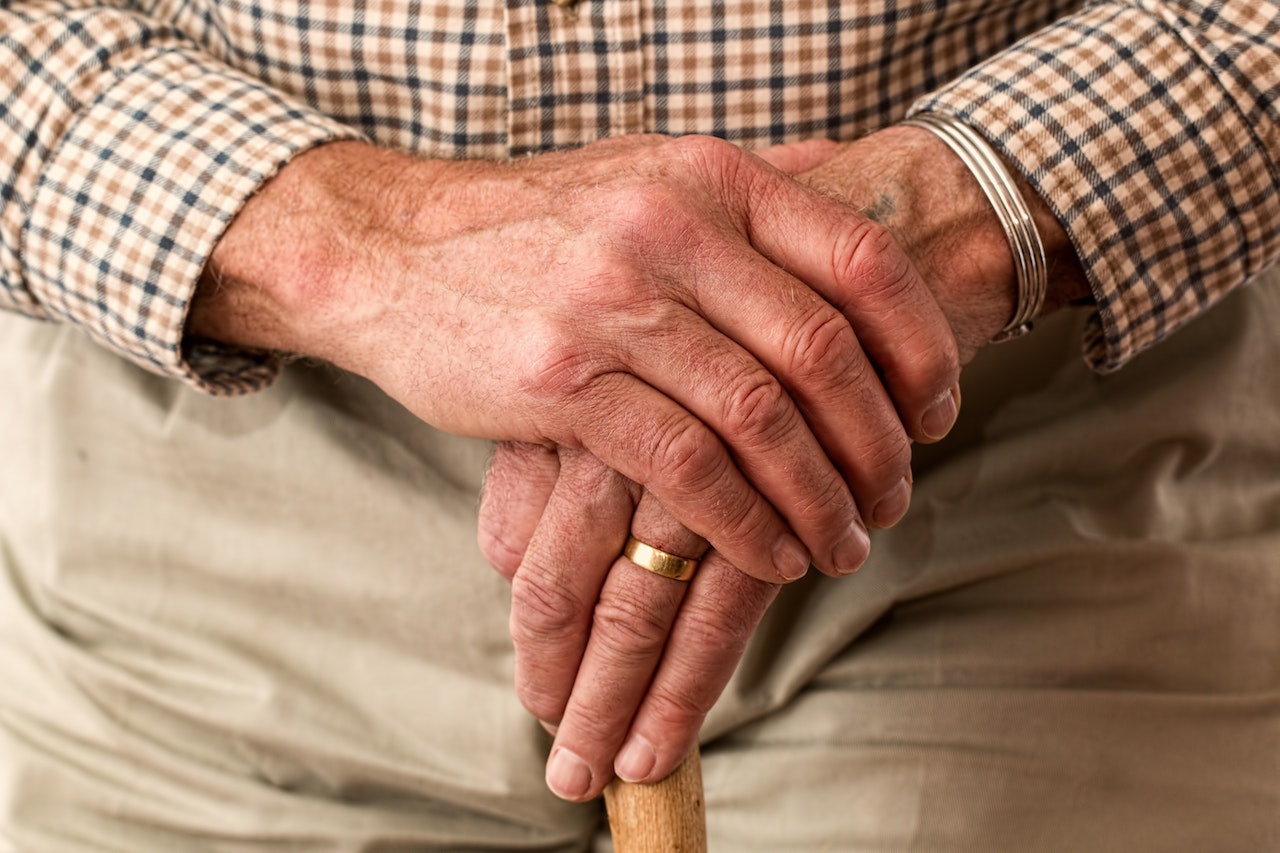
Additional Considerations
In addition to the core safety measures, there are important additional considerations that can further enhance home safety for seniors. Regular maintenance and inspections of home safety equipment, such as fire extinguishers and detectors, ensure proper functioning. Communication devices, like mobile phones or specialized landline phones, provide easy access to emergency contacts. Personal safety devices, such as wearable panic buttons or GPS trackers, offer an extra layer of security and peace of mind. By incorporating these additional considerations into their safety plans, seniors can maximize their home safety and be well-prepared to respond to emergencies effectively.
What education and awareness initiatives can be implemented to empower seniors with knowledge about fall prevention strategies and the importance of proactive self-care?
Falls are the leading cause of fatal injury and the most common cause of nonfatal, trauma-related hospital admissions among older adults. For many elders who have a fall, this is often the beginning of a deleterious cascade of ill health that will lead to trauma, hospitalization, decreased mobility, depression, and in some cases, even death. The sad thing about these statistics is that, for many seniors, falls are largely preventable. It all starts with an honest and caring conversation with a senior to talk about the issue of balancing safety with autonomy. If you have a family member or close friend who has fallen or is at risk of falling, share your concern and take a quick fall history.
Some of the questions you should ask include:
- Have you had a fall in the past year?
- If so, where and how?
- If so, how many and were you hurt?
- Do you feel unsteady when standing or walking?
- Do you worry about falling?
- Do you feel dizzy/lightheaded when you change position?
- Do any of your medications make you feel dizzy/lightheaded on a consistent basis?
Risk factors for falls include chronic medical conditions such as arthritis, spinal disease, Parkinson’s disease, stroke, multiple sclerosis, neuropathy, and diabetes. Seniors with cognitive impairment are also at greater risk for falls because of impulsivity and poor judgment. Visual impairment is also important to consider, along with the side effects of medications and environmental factors. Not to be ignored is the actual fear of falling. This can stop a senior from participating in activities and exercise, which can, in turn, lead to weak legs and further increase the risk for falls. It also contributes to social isolation and depression.
Based on the falls history and risk factors identified, some initiatives to reduce falls include:
- A thorough review of medications with a healthcare provider to ensure that none of these are contributing to gait unsteadiness
- Having vision evaluated
- Exercise safely and regularly to improve your balance and strength
- If appropriate, get a referral from a healthcare provider to a physical therapy program
- Consider a home safety assessment by a qualified professional such as an occupational therapist or Aging Life Care Professional to help identify ways to make your home safer
- Community resources include local workshops in community senior centers, online downloadable resources or in-person seminars from Physical and occupational therapy groups, community exercise classes, and social groups
Anne Sansevero from Aging Life Care Association
Importance of emergency preparedness and steps seniors should take to be prepared
Extreme weather and other natural or human-caused emergencies generate riveting headlines reporting unthinkable human tragedies with devastating damage to property and nature. Seniors can be at greater risk because they are often unable or reluctant to mobilize quickly, and some have historical memories of lived-through experiences (“Anchoring Effect”) of past natural disasters and think the next one will be similar–when it may not be.
Conditions can quickly deteriorate when stress or medications are unavailable or house-bound individuals are cut off from help (invisible and isolated). For these reasons, older adults must have a plan in place.
Four Steps:
- Establish an emergency support network
- Register for help (disasterassistance.gov)
- Have a plan for pets
- Create an emergency preparedness kit
The website ready.gov has emergency plan essentials, and the Red Cross has information on preparing an emergency kit.
Other considerations:
- Ensure accessibility by identifying accessible evacuation routes
- Include Personalize emergency kits catering to specific medical needs (updated)
- Establish an emergency communication plan with a support network, caregivers, or local authorities. For seniors living in areas where emergency medical services play a crucial role, leveraging tools like EMS ePCR software can streamline the process of sharing critical medical information with first responders, ensuring timely and accurate care during emergencies.
- Seek education and training on disaster preparedness
A standby power generator also makes life-saving sense. These action steps will enhance older adults’ ability to withstand and respond to challenging situations.
Patrick Roden, Ph.D. from aginginplace.com Author of the new book Women, Aging & Myths: 10 Steps to Loving Your Long Life
Keeping people with dementia safe in their homes
Adding signs throughout a home can make it more manageable for individuals with dementia to navigate the property. Focus on critical areas such as the bathroom, bedroom, kitchen, and exit points. These areas are crucial for maintaining independence. Consider additional signs for closets, medicine cabinets, or other areas of potential confusion. Use clear and simple text. You can also incorporate visual cues such as pictures to make the signs more intuitive. You can find ready-made stock images and icons online or create simple drawings to represent different rooms or objects. Test out customizing signs to include the person’s name or personal touches. This can create a sense of familiarity and ownership, making the signs more recognizable.
However, signs alone may not suffice. Try to put yourself in the person’s shoes by imagining how you feel when you’re in an unfamiliar environment such as an airport or large retail store. Even if you know what the bathroom looks like, it can be hard to locate in these situations. As a result, you may want to use arrows or other directional cues to help guide the person with dementia in the right direction. This can be particularly useful in hallways or areas where there are multiple choices or turns. Remember that adding signs is just one part of creating a dementia-friendly environment. It is essential to combine signs with other safety measures and supportive strategies to ensure the person’s overall well-being.
Final thoughts
By implementing the tips and recommendations discussed in this article, seniors can take proactive steps to create a safer home environment and significantly reduce the risk of injuries. Prioritizing safety will empower older adults and enhance their overall well-being and maintain their independence for as long as possible. A safer home environment not only reduces the risk of accidents and injuries but also provides peace of mind to seniors and their loved ones. With a secure and supportive living space, seniors can continue to enjoy their daily activities, maintain their autonomy, and age in place comfortably.
